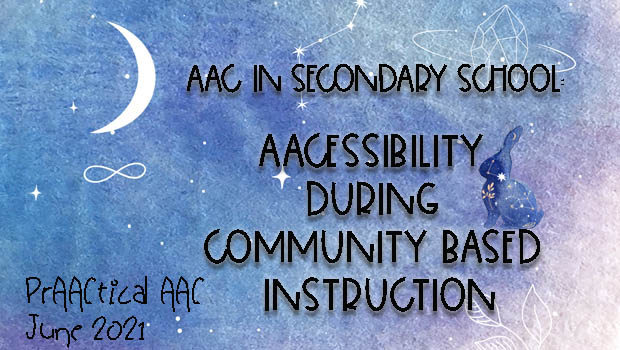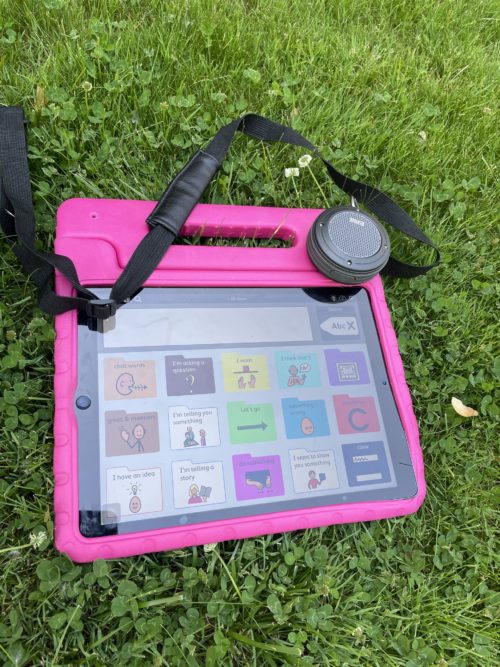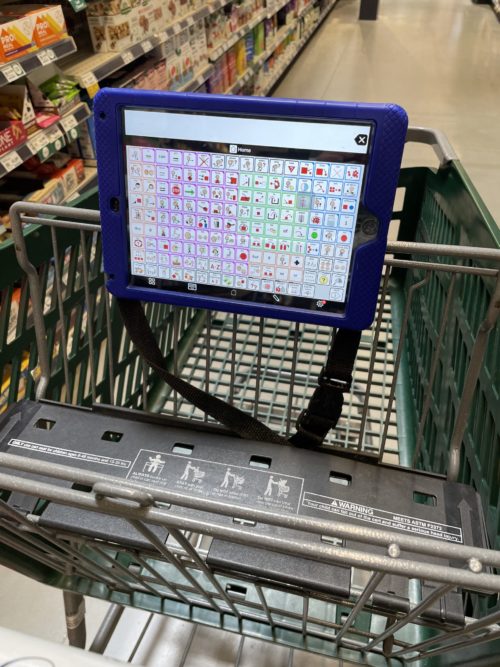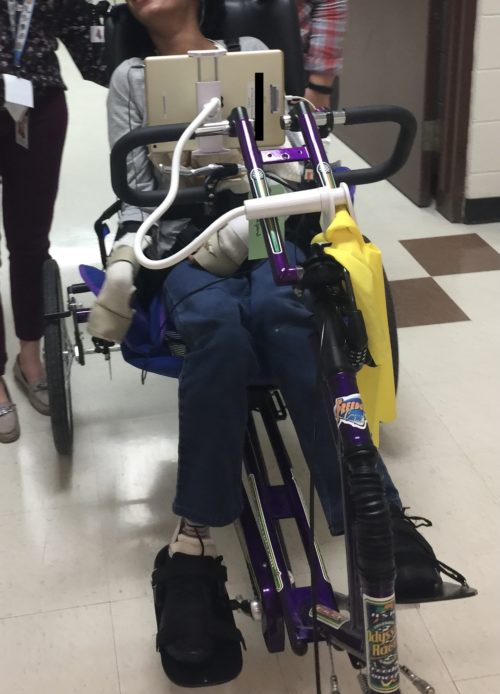AAC in Secondary School: AACcessibility during Community Based Instruction

 Many students who use AAC spend some time in community-based instruction during their teenage years. In today’s post, AAC SLP Ashley Larisey discusses this topic in a continuation of the AAC in Secondary School series.
Many students who use AAC spend some time in community-based instruction during their teenage years. In today’s post, AAC SLP Ashley Larisey discusses this topic in a continuation of the AAC in Secondary School series.
Ashley is an SLP at Community High School District 218 in Oak Lawn, Illinois. She is also an Adjunct Clinical Supervisor and Instructor at Saint Xavier University. Additionally, Ashley presents on AAC topics at professional conferences.
Enjoy!
::::::::::::::::::::::::::::::::::::::::::::::::::::::::::::::::::::::::::::::::::::::::::::::::::::::::::::::::::::::
AACcessibility During Community Based Instruction
Community-Based Instruction (CBI) is a meaningful, engaging, and highly motivating experience for many students with disabilities, particularly those students who are high-school-aged and beyond. For AAC users, CBI provides opportunities to communicate with unfamiliar communication partners for many different purposes. However, when students are out and about, it can be easy to overlook the ease of access that can exist within the educational environment. However, it is just as important for AAC to be easily accessible during CBI, so that all of the communication skills that have been practiced within the classroom can be applied within functional and meaningful contexts. Here some tips to make sure your students have access to AAC all the time.
Noisy Environments
Concerts, sporting events, and pep assemblies, and especially a high school lunchroom can be NOISY. Although we might not encounter these environments much lately due to the pandemic, hopefully, opportunities to re-engage in these activities are just over the horizon. The problem with noisy environments for AAC users is that they often make hearing the voice output within a communication device inaudible, despite the volume being at maximum levels.
Bluetooth speakers can be paired with iPads and some dedicated communication systems to help “amp up” the volume so that an individual can be heard within a noisy environment. Using something small that can be attached with a carabiner could be a practical solution to help combat issues with loudness. Some external cases for iPads also come with amplification that can increase the volume using the acoustic design of the case or via built-in Bluetooth technology. A word of caution; not all Bluetooth speakers are created equal! It can be helpful to purchase a few different options and return ones that do not fit the needs of the AAC user or are not compatible with their system.

Photo of iPad with Bluetooth speaker
Accessibility across environments
In situations where AAC users are either a) out and about or b) need to use their hands for other purposes (gardening, shopping, etc.) it can be helpful to look within the immediate environment to see if there is a safe location to place the AAC device. A good example of this would be to use the grocery cart to hold the device while shopping at the store or placing it on the bookstand of a treadmill.

Photo of iPad on grocery cart
Carrying straps or harnesses can be helpful for students who prefer and are able to have their AAC on their person. This blog post from Northwest Augmentative Communication Society (NWACS) provides different options for carrying straps with links to handles, straps, and harnesses with features that could meet the needs of many individuals.
Mounting systems can be useful for tables, carts, or even bicycles to ensure that AAC systems are accessible when there are other materials on a work surface or when an AAC user is using their hands for other purposes. There are multiple methods of attachment for mounting systems and several different styles available. This Pinterest board from Lauren Enders features several different mounting systems for AAC devices.

iPad mounted on adapted bike using a clamp flex mount: 5 Below
At times, AAC devices are simply not compatible with particular environments (e.g. swimming). Using low-tech communication boards or systems in these environments provide AAC users with the opportunity to communicate with flexibility. Get creative! It is important to ensure that there is an “I need my communication book” or “I need my AAC device” option when using AAC supports that are not identical to the individual’s language system.
Remember: Accessibility belongs to the AAC user!
As professionals, we often try hard to help our AAC users find solutions to ensure that they can access their AAC at all times, but ultimately this choice belongs to the individual. We can present different options and help troubleshoot, but access is about what works best for the individual.
Making Phone Calls
…but how does this fit into CBI? Making phone calls can be a big part of planning a CBI trip as well as a way to communicate when you are out and about. Got split up from your group and need to reconnect? Can’t remember what time your bowling reservation was and need to confirm? Making phone calls as part of CBI is a functional way to communicate with individuals who are not in the immediate environment, but poses some unique considerations for AAC users.
Until somewhat recently, making phone calls from an iPad while using AAC was not possible due to limitations in Apple software. However, many AAC apps now have the ability to place phone calls via Facetime video or audio directly from the device (when connected to WiFi or supported with data). Here are some instructions on how to set up phone calls using specific systems and/or tools.
* Note: this list is not comprehensive: check the user manual of your specific AAC system for information on making phone calls.
Next Steps
CBI integrates well into educational settings and can infuse topics that are being discussed in the curriculum, but it doesn’t have to stop there! Out and About groups (Wagner, Musselwhite, & Odom, 2005) provide an excellent framework for socialization among AAC users while getting “out and about” within their own communities. A detailed explanation of Out and About groups is available here.
What ideas do you have about accessibility in Community-Based Instruction? Comment below – I’d love to hear your ideas!
Resources
- Northwest Augmentative Communication Society. 10/21/19 updated 3/9/21. Retrieved from https://www.nwacs.info/blog/2019/10/carrying-straps-for-aac-devices
- AAC Mounts for AAC Devices via Lauren Enders. Retrieved from https://www.pinterest.com/lasenders/aac-mounts-for-aac-devices/
- Out and About: AAC in the Community. Deanna Wagner, Caroline Musselwhite, and Jane Odom. Retrieved from https://www.teacherspayteachers.com/Product/Out-and-About-AAC-in-the-Community-2560404
Filed under: Featured Posts, PrAACtical Thinking
This post was written by Carole Zangari
